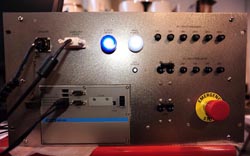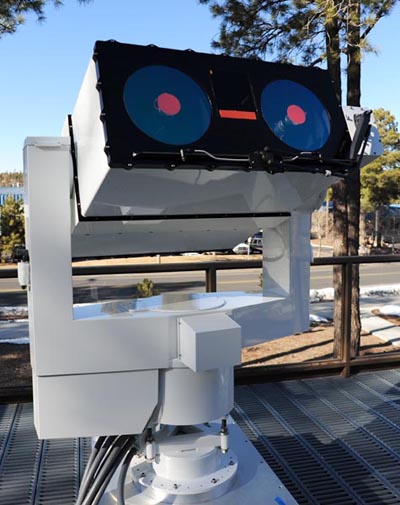Severe Environment, All Weather Capability...
RCOS Severe Environment, Satellite and Orbital Debris Tracker. See video here.
Telescope Pointing Systems have to be designed to operate effectively in many different environmental conditions. RC Optical Systems has addressed the requirements to operate instrumented tracking systems in conditions of -20F degrees below zero and +110F degrees, and developed techniques to meet a survival temperature of -40F degrees to +130F degrees with a low power active monitoring system for heating and cooling.
The Survival Range is the outside temperature during non-operating mode with all systems turned off (save for trickle power available for devices not capable of meeting the survival temperature i.e. cameras). Operating Range is the outside temperature during operation of the equipment. The operating environment may be so hostile that local manned operation is not possible. The system must be able to be operated remotely such that cleaning of optics, power cycling, heating and cooling, calibration, and operation of the instrumentation (focusing of optics and camera control) can be done for an unmanned system.
The RCOS Severe Environment (SE) Mount and Controller’s critical components operate at 0 degrees F and many at -40 degrees F. The sealed bearings, brushless DC torque motors, encoders, and critical Controller electronics are chosen for use in a severe environment.
This Mount design incorporates many innovative features for protecting electronics, shielding outside entrances, and providing a protected instrumentation enclosure. There are both passive and active controls to monitor temperature and other information and to turn on and turn off heating and cooling systems. Various heating and cooling devices are available as options such as active cooling (fans), heating strips, thermo electric cooler, heat exchanger, and dehumidifier, and these can be sized appropriately to the task.
The interface between Mount and Controller is limited to bus power, E-Stop, and Ethernet. RCOS SE features are:
1). Minimizing interconnects between the rotating gimbal and the base.
2). Fiber optic transmission of data or images.
3). Not allowing exposed cables and wires.
4). Use of reliable, easy maintenance bulkhead connectors between subsystems.
5). Fail safe brakes.
6). Dual encoder read heads.
 The critical motion control electronics and servo drive electronics are located inside the Mount and supporting electronics are in a 8U rack mount chassis or NEMA 12 style enclosure for outdoor use.
The critical motion control electronics and servo drive electronics are located inside the Mount and supporting electronics are in a 8U rack mount chassis or NEMA 12 style enclosure for outdoor use.
We use a shingle style construction for the Mount panel structure to aid in the weatherproofing and minimize the use of gaskets. Also we use ‘labyrinth’ couplings for protection on outside seals.
The instrumentation bay is in a sealed enclosure (optionally pressurized) containing the cameras, focus mechanisms, and signal converters. A wiper blade system is used to clean the entrance window of the instrumentation enclosure and is controlled remotely. A number of different materials are used for the skins of the instrumentation enclosure such as fiberglass, aluminum alloy, or carbon nomex.
 Control of the Telescope focusing mechanism and environmental monitoring is done with the RCOS Telescope Interface Module. This is an ASCOM compatible device that allows for remote control/script management of the electronics subsystem. Once the system reaches readiness for tracking, it receives all its tracking commands remotely. The RCOS SE Mount is supported for use with our COTS LEO Tracking Software.
Control of the Telescope focusing mechanism and environmental monitoring is done with the RCOS Telescope Interface Module. This is an ASCOM compatible device that allows for remote control/script management of the electronics subsystem. Once the system reaches readiness for tracking, it receives all its tracking commands remotely. The RCOS SE Mount is supported for use with our COTS LEO Tracking Software.
Features |
Specifications |
Comments |
Look down |
- 30° |
Configurable |
Azimuth rotation |
±270° Cable wrap |
Slip ring option available |
Elevation rotation |
-30° to +95° |
-30° to +210° Turn and Dump capable |
Max. Acceleration |
50°/sec² |
Options for higher acceleration available |
Max. Velocity |
50° per second |
Options for higher velocity available |
Weight |
800lbs |
Subject to final configuration |
Power Consumption |
|
Based on final configuration |

